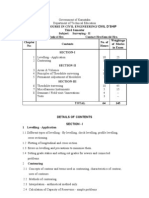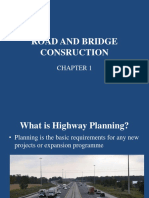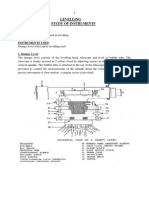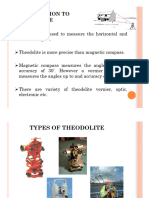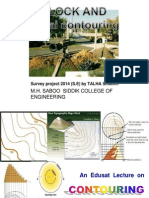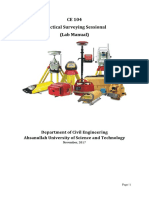Linear Measurement
Linear Measurement
Uploaded by
EchaNurulAisyahCopyright:
Available Formats
Linear Measurement
Linear Measurement
Uploaded by
EchaNurulAisyahOriginal Description:
Copyright
Available Formats
Share this document
Did you find this document useful?
Is this content inappropriate?
Copyright:
Available Formats
Linear Measurement
Linear Measurement
Uploaded by
EchaNurulAisyahCopyright:
Available Formats
3.
Unit CIV2202: Surveying
Topic 3: Linear Measurement (Taping or Chaining)
CIV2202. 3: LINEAR MEASUREMENT
(TAPING OR CHAINING)
Table of Contents
PREVIEW .........................................................................................................................3
Introduction............................................................................................................3
Objectives ..............................................................................................................3
Readings ................................................................................................................3
DISTANCE MEASUREMENT ........................................................................................4
2 Types Of Distance Measurement........................................................................4
USE OF STEEL TAPES ...................................................................................................4
FIELD WORK CONSIDERATION .................................................................................4
MEASURING LESS THAN ONE TAPE LENGTH........................................................5
MEASURING MORE THAN ONE TAPE LENGTH .....................................................5
Procedure ...............................................................................................................5
Notes
7
STEP CHAINING ON SLOPING GROUND ..................................................................7
Procedure ...............................................................................................................7
STANDARD TAPE CORRECTIONS..............................................................................8
How do we measure the slope angle Q ...............................................................8
Procedure ...............................................................................................................8
Slope ......................................................................................................................9
Measuring Q: Levels at A and B are known : ......................................................9
Use/Age ...............................................................................................................10
Tension ................................................................................................................10
Temperature.........................................................................................................11
Sag of the tape .....................................................................................................11
BOOKING.......................................................................................................................12
Booking a Baseline ..............................................................................................12
ERRORS AND ACCURACY.........................................................................................13
Sources of Errors .................................................................................................13
TYPICAL ACCURACY FIGURES ...............................................................................13
EXERCISE ......................................................................................................................14
CHAINING AND DETAIL SURVEY ...........................................................................14
Basic Approach....................................................................................................14
Principles .............................................................................................................15
Department of Civil Engineering, Monash University
Edition 6/2002
3.2
Unit CIV2202: Surveying
Topic 3: Linear Measurement (Taping or Chaining)
Method.................................................................................................................15
Booking................................................................................................................16
Plotting.................................................................................................................16
EXERCISE ......................................................................................................................17
SUMMARY ....................................................................................................................17
REVIEW QUESTIONS ..................................................................................................17
ANSWERS TO REVIEW QUESTIONS ........................................................................18
Department of Civil Engineering, Monash University
Edition 6/2002
3.3
Unit CIV2202: Surveying
Topic 3: Linear Measurement (Taping or Chaining)
PREVIEW
Introduction
This chapter is about the skill of producing a site plan using just 2 tapes with the
addition of a clinometer for measuring slope angles. (Distance shown on plans must
always be horizontal distances).
The chapter is divided into two sections. The first (Distance Measurement) describes
basic use of tapes, and adjustments for the effects of slope, temperature, tension etc. The
second (Chaining) describes the application of these skills in producing a site plan. You
will use these skills as part of your practical assignment.
These are useful skills for producing small site plans. However, most larger plans are
now produced using a theodolite and EDM. More about that later.
You should notice that future chapters include a Skill section at the start. Hopefully,
these will help you to identify what is most important in that chapter. These will be the
skills you will be practising in your practical and camp assignments.
Objectives
After completing this topic you should be able to:
obtain horizontal distances in sloping terrain
correct linear measurements for site and environmental factors
understand procedures for producing a site plan using only linear measurement
Readings
Read: Muskett, Sections 4.1, 4.2
(? Minutes)
REQUIRED
Department of Civil Engineering, Monash University
Edition 6/2002
3.4
Unit CIV2202: Surveying
Topic 3: Linear Measurement (Taping or Chaining)
DISTANCE MEASUREMENT
2 Types Of Distance Measurement
1.
direct - tapes, bands, chains
2.
indirect - optical (theodolite), EDM
USE OF STEEL TAPES
*
typically 20, 30, 50, 100 m
many tapes are fibre reinforced plastic, but for accurate work, they must be
steel (which are often be plastic coated). Plastic tapes stretch with age.
always check the exact position of the zero mark. It is usually at the end of the
link on the end of the tape, not at the end of the steel ribbon.
manufactured to give precise length when
(i)
new
(ii)
standard temp (20C)
(iii) standard tension (eg. 5kgf or 49N)
*
corrections can be made for these (more about this later).
FIELD WORK CONSIDERATION
The aim is to measure the straight-line, plan distance between 2 points
*
so, you must be careful to measure in a straight line
correct for slope angle to give plan length
Department of Civil Engineering, Monash University
Edition 6/2002
3.5
Unit CIV2202: Surveying
Topic 3: Linear Measurement (Taping or Chaining)
For example ...
MEASURING LESS THAN ONE TAPE LENGTH
*
tape on the ground,
pull to standard tension,
on a straight line, tape must be straight in the vertical plane too.
read the length (and remember to check the zero mark).
MEASURING MORE THAN ONE TAPE LENGTH
Need (i)
(ii)
3 (or more) ranging poles,
some marking arrows:
Procedure
(i)
need 2 people : leader and follower
Department of Civil Engineering, Monash University
Edition 6/2002
3.6
Unit CIV2202: Surveying
Topic 3: Linear Measurement (Taping or Chaining)
(ii)
erect ranging poles at end points (A and B) - as near vertical as possible
(iii)
set zero end of tape at A by follower.
(iv)
leader moves forward and places a ranging pole a short distance from the end
of the tape
(v)
follower sights the pole onto the line AB by stepping back from A (see next
diagram).
(vi)
straighten tape against new pole, and place arrow at exact end of tape
(exactly one whole tape length)
(vii)
leader and follower move forward and repeat from the last arrow position.
The number of arrows eventually equals number of whole tape lengths.
Miscounting the number of tape lengths or 10 m steps is a common source of
error.
(viii) repeat measurement from B to A as a check, if time and budget allow it. There
are other ways of checking your work, which will be discussed in future topics.
Department of Civil Engineering, Monash University
Edition 6/2002
3.7
Unit CIV2202: Surveying
Topic 3: Linear Measurement (Taping or Chaining)
Notes
Ranging with a theodolite (set at A) increases accuracy. For non-horizontal ground, this
step may be essential, because it may not be possible (or at least difficult) to sight by
eye, for example ...
STEP CHAINING ON SLOPING GROUND
Procedure
(i)
Use previously ranged in poles
(ii)
Use horizontal tape (checked by third person some distance away).
(iii)
Compare the angle of the tape with the lines of buildings which are parallel
to the line you are measuring, or
Compare the angle of the tape, near the mid point of the span, with a
plumbline - you should have four equal angles.
Transfer horizontal distance to ground using plumb bob, preferably at whole
metre mark.
Department of Civil Engineering, Monash University
Edition 6/2002
3.8
Unit CIV2202: Surveying
Topic 3: Linear Measurement (Taping or Chaining)
(iv)
Keep maximum length of tape to 10 m
(reduces problem of catenary or sag).
(may need to be less on steep ground to reduce the vertical step to a maximum of
1.5m).
Applications:- short survey lines (eg. offsets, setting out of building etc.
STANDARD TAPE CORRECTIONS
How do we measure the slope angle ?
The simplest method is the Abney level or clinometer
Procedure
1.
Mark the eye height of the observer on a ranging pole
2.
Sight from A to B. First adjust the coarse screw, then the fine adjustment
screw, to bring the level bubble to the central position, so that target 'B',
cross hair and bubble are coincident.
3.
Read the angle to the nearest 10' by the vernier scale.
4.
Check and eliminate Abney error by sighting from B to A and repeating process.
Use the mean of the two angles.
Better accuracy by using a theodolite, but not justified in many cases. In this case, mark
the height of the trunnion axis on the ranging pole and sight of this mark.
Department of Civil Engineering, Monash University
Edition 6/2002
3.9
Unit CIV2202: Surveying
Topic 3: Linear Measurement (Taping or Chaining)
Slope
We define C, the correction, such that:
D=L+C
where
D = actual (corrected) length
L = measured length
C = correction (hence, C is always added)
or,
C=D-L
= L.(cos ) - L
= L.(cos - 1)
since cos 1, C is always negative (or zero) - as expected!
Measuring : Levels at A and B are known :
if h = difference in level
h 2
then, correction, C =
(for small h)
2L
Note that the correction is negative as before.
Department of Civil Engineering, Monash University
Edition 6/2002
3.10
Unit CIV2202: Surveying
Topic 3: Linear Measurement (Taping or Chaining)
Use/Age
Tapes tend to stretch with age. We need a reference tape or standard length for
comparison. We can check the tape on a flat surface (if reference tape is the same
material, temp differences from standard (eg. 20C) won't matter).
Say tape measures 30.011 m instead of 30 m, measurements must be corrected as
follows.
Lc = L . (la / ln)
Lc
L
la
ln
= real or corrected length
= measured length
= actual length (30.011 m)
= nominal length (30 m)
Expressed as a correction, C:
C
C
= Lc - L
= L. (la/ln - 1)
= 0.00037 L for the above example
Note: Correction is positive in this case, because the tape has stretched, ie. the actual
distances are larger than measured ones.
Take care to make sure that the sign of the correction is correct.
Tension
Tapes and bands are designed for standard tension (in our case 5 kgf or 49 N).
Use a spring balance and roller grip to achieve this.
Use the spring balance at the leader's end of the tape, not the follower's or zero end.
For other than standard tension, correction, C is:
L(TF TS )
A.E
L
= Length measured
= Tension in the Field
TF
TS
= Tension, Standard
A
= cross-sectional Area
E
= Young's modulus
C=
Department of Civil Engineering, Monash University
Edition 6/2002
3.11
Unit CIV2202: Surveying
Topic 3: Linear Measurement (Taping or Chaining)
Note: if TF > TS, actual length is more than what was measured and hence C is
positive.
Temperature
Tapes are correct usually at 20C.
For non-standard temperature:
C
a
tS
tF
= a.L.(tF - tS)
= coefficient of thermal expansion
= 0.0000112 /C for steel
= standard temp
= field temp
Note: if tF > tS, tape is longer, so actual lengths are more than measurements, and
hence C must be positive.
Sag of the tape
A tape suspended by its ends forms a catenary under gravity
It is possible to derive the actual shape from structural theory:
C-
TF
w2.L3.cos
24.TF2
= unit weight of tape (N/m)
= angle from A to B (as shown above)
= field tension (N)
Note that this corrections is always negative (ie. actual distances are always shorter than
the measurements).
Department of Civil Engineering, Monash University
Edition 6/2002
3.12
Unit CIV2202: Surveying
Topic 3: Linear Measurement (Taping or Chaining)
BOOKING
In surveying it is very important to follow a systematic and standard method of
recording information, because :
(i)
things are usually plotted some time after the survey,
(ii)
the plotter is often not the surveyor (often a drafter).
Booking a Baseline
Date: 5 Mar 91
Team: RGH & DBC
Booked: DBC
Notes:
(i) mean temp 30C
(ii) tape on ground
at standard tension
Corrections:
1. Standardisation
nominal L = 30.000 m
actual L = 30.012m
C = 101.234[(30.012/30) - 1]
= +0.040 m
2. Temperature
C = 0.0000112 x 101.234
x (30 - 20)
= + 0.011 m
3. Slope:
C = 30(cos 120' - 1)
+ 45.5 (cos 150' - 1)
+ 25.73 (cos 230' - 1)
= - 0.055 m
XY = 101.234 + 0.040
+ 0.011 - 0.055
= 101.230 m
Y
101.234
----------------
90
230' slope
75.5
-----------------
60
150' slope
30
0
X
---------------120' slope
-----------------
Department of Civil Engineering, Monash University
Edition 6/2002
3.13
Unit CIV2202: Surveying
Topic 3: Linear Measurement (Taping or Chaining)
ERRORS AND ACCURACY
Sources of Errors
(i)
incorrect tape length (eg. the tape has stretched) - standardize
(ii)
incorrect slope (a clinometer gives 1:5000 accuracy for angles up to 4).
For example, the maximum error with a clinometer is 5' (with 10' graduations)
Slope
1
3
5
max. error (mm/100 m)
3
8
12
(iii)
tapes must be correctly tensioned for better than 1:5000 accuracy.
(iv)
similarly for temperature
(v)
take care to measure in a straight line.
(vi)
make sag correction for accurate work.
(vii)
check for gross errors by measuring each line (at least) twice.
TYPICAL ACCURACY FIGURES
Accuracy
1:500
Required for
Corrections
slope
soil heaps
soft detail
1:5000
1:10000
1:20000
better than
1: 20000
slope
+ standardize
sewer pipes
hard detail
traverse legs,
road centrelines,
grids, baselines,
setting out,
secondary control
primary control
+ tension
+ temp
horiz. surfaces
sag corrections
use EDM
Department of Civil Engineering, Monash University
Edition 6/2002
3.14
Unit CIV2202: Surveying
Topic 3: Linear Measurement (Taping or Chaining)
EXERCISE
Do Problem 4/1 from Muskett. This exercise lets
you practise some of these corrections.
CHAINING AND DETAIL SURVEY
Read Muskett, sections 6.1, 6.2
REQUIRED
Read: Fryer & Elfick
SUGGESTED
To produce a plan or map of an area showing the important features using just linear
measurement (often called a detail survey).
Basic Approach
a.
establish control lines and control points (located by triangulation).
b.
pick up detail using offsets (be careful to measure true horizontal distances).
Department of Civil Engineering, Monash University
Edition 6/2002
3.15
Unit CIV2202: Surveying
Topic 3: Linear Measurement (Taping or Chaining)
Principles
1.
there should be at least one good line through the area, on which the survey
is based.
2.
if the survey is extensive, develop a few long lines rather than many short
ones (eg. a large triangle)
3.
try for well-conditioned triangles (close to equilateral) - no angles less than
30.
4.
where possible measure some check lines (redundancy).
5.
put control lines as close as possible to detail, so offsets are short.
Method
1.
Reconnoitre the area and decide where lines will go. Draw a rough sketch.
2.
Establish stations (points of triangles) as wooden pegs, and give each a
letter on the sketch.
3.
Measure all the control lines, and check lines, once in each direction. Don't
forget corrections.
4.
Finer detail can be measured by offsets (swing the tape over the offset line the shortest distance will occur for the perpendicular).
NB:
Offsets should be kept short to avoid making corrections (less than 20 m).
Department of Civil Engineering, Monash University
Edition 6/2002
3.16
Unit CIV2202: Surveying
Topic 3: Linear Measurement (Taping or Chaining)
5.
Develop additional triangles as needed to keep offsets short.
6.
Measure widths of features (eg. roads, drains, trees, etc), lengths of sides of
buildings, radius of circular features.
7.
A level (or similar) must be used if elevations are required.
Booking
Booking must be neat and consistent.
It must be capable of being plotted by someone else.
Use explanatory notes and sketches liberally.
Continue long lines over as many pages as necessary.
Use a column up the centre of the page for the chained line distance, and show
offsets or ties to detail on either side. See Muskett 2ed. P157.
Add dimensions around buildings in parentheses.
Include slopes on overall sketch so corrections can be made.
Don't forget miscellaneous data - name, date, location, and initials.
Add a compass bearing of at least one line for plotting purposes.
Plotting
Do not, under any circumstances, use a plan scale of 1:300,
1:150, etc, no matter how attractive it may seem! Suitable scales
are 1:100, 1:200, 1:250, 1:500, 1:1000.
1.
Start with longest line and build framework of major lines.
2.
Position longest line on sheet in an appropriate position.
3.
Plotting may show errors in original data - remeasure if necessary.
4.
Include offsets to features.
5.
Fill in detail, with notes, legend, etc.
Department of Civil Engineering, Monash University
Edition 6/2002
3.17
Unit CIV2202: Surveying
Topic 3: Linear Measurement (Taping or Chaining)
EXERCISE
Activity
Do exercise 6.1 from Muskett, p183.
SUMMARY
Horizontal distances are required for map and plan preparation, and for most
engineering purposes. In sloping terrain, horizontal distances may be obtained either by
step measuring with the tape set horizontal, or by measuring along the slope and
applying trigonometry to obtain the horizontal distance.
In practice, corrections may have to be applied to taped measurements to compensate
for:
a tape that is either too long or too short
measurements taken along sloping ground
sag in the tape, when measuring across a gully or similar feature
measurements made when the temperature is either greater of less than the tapes
standard temperature
measurements made with tape tension other than standard.
REVIEW QUESTIONS
1.
If you measure with a steel tape between two ground marks approx. 500 m apart
when the field temperature is 30oc, will your recorded measurement be too short
or too long? What is the magnitude of the difference from standard
measurement.
2.
You measure across a gully to pegs placed on the centreline of a proposed dam.
Your recorded distance is 70.25 m, at a tension of 50 kN. Your 100 m long tape
weighs 1.2 kg. What is the correction to your distance? Will you add or
subtract this amount?
Department of Civil Engineering, Monash University
Edition 6/2002
3.18
Unit CIV2202: Surveying
Topic 3: Linear Measurement (Taping or Chaining)
ANSWERS TO REVIEW QUESTIONS
1.
The steel tape is standard length at a temperature of 20oc.
Correction = 500 x 0.0000112 x (30 20) = 0.056
This must be added to the recorded distance.
2.
Mass of tape
= 1.2 kg
Weight of tape per metre
1.2 x 9.8
100
= 0.1176 kN
Correction
(0.1176) 2 x (70.25) 3
=
24 x50 2
= 0.080 m
Department of Civil Engineering, Monash University
Edition 6/2002
You might also like
- Traverse Error and Correction PDFDocument43 pagesTraverse Error and Correction PDFRajendra K Karki100% (1)
- PRE VOCATIONAL PACKAGE - DOs21Document6 pagesPRE VOCATIONAL PACKAGE - DOs21MA Vic100% (1)
- Chapter 2 - Levelling (CIVIL ENGINEERING-ENGINEERING SURVEY)Document33 pagesChapter 2 - Levelling (CIVIL ENGINEERING-ENGINEERING SURVEY)second mnwwrh100% (1)
- Surveying Lecture Notes PDFDocument98 pagesSurveying Lecture Notes PDFpaul macharia100% (2)
- Lecture 1b Precise LevellingDocument30 pagesLecture 1b Precise LevellingNur Fatin Are Tien58% (12)
- Levelling Problems 1 Rise&FallDocument9 pagesLevelling Problems 1 Rise&FallAftab Jiskani100% (4)
- Traversing Notes - Surveying II - Sudip Khadka - CivilengineeringDocument37 pagesTraversing Notes - Surveying II - Sudip Khadka - CivilengineeringSudip KhadkaNo ratings yet
- Surveying IIIDocument7 pagesSurveying IIIShaik Jhoir100% (2)
- Surveying IIDocument7 pagesSurveying IIVikram Rao100% (1)
- Chain SurveyingDocument13 pagesChain SurveyingAsharudheen Kasim100% (3)
- Setting Out of Horizontal CurvesDocument1 pageSetting Out of Horizontal Curvesshayhaq88% (8)
- Report TheodolitesDocument18 pagesReport TheodolitesSYAZWANI HUSNA50% (2)
- Triangulation in SurveyingDocument6 pagesTriangulation in SurveyingShiela Mae Sales100% (1)
- Asphalt Surfaced Roads and Parking Lots Condition Survey Data Sheet For Sample UnitDocument2 pagesAsphalt Surfaced Roads and Parking Lots Condition Survey Data Sheet For Sample UnitEchaNurulAisyahNo ratings yet
- Black Widow: Forever Red ExcerptDocument110 pagesBlack Widow: Forever Red ExcerptDisney Publishing80% (25)
- Survey Lecture Notes 3Document1 pageSurvey Lecture Notes 3mogijo11dffdfgdfgNo ratings yet
- Lesson 2 - Chain SurveyingDocument34 pagesLesson 2 - Chain SurveyingBryanNo ratings yet
- Exp # 14 (Theodolite Traversing)Document2 pagesExp # 14 (Theodolite Traversing)Sudin Pradhan100% (1)
- Surveying Lab ManualDocument77 pagesSurveying Lab ManualAtish Kumar88% (8)
- Surveying & GeomaticsDocument14 pagesSurveying & GeomaticsRenjith S Anand0% (1)
- SURVEY PRACTICAL LABORATORY MANUAL PartDocument41 pagesSURVEY PRACTICAL LABORATORY MANUAL PartManiko ManikoNo ratings yet
- Tacheometry: Lesson 23 Basics of Tacheometry and Stadia SystemDocument20 pagesTacheometry: Lesson 23 Basics of Tacheometry and Stadia SystemMuhammed AliNo ratings yet
- Surveying I Lab Manual PDFDocument59 pagesSurveying I Lab Manual PDFHaris Alam70% (10)
- Assignment On LevelingDocument12 pagesAssignment On LevelingAlebachew100% (2)
- Module 1:tacheometric SurveyDocument29 pagesModule 1:tacheometric SurveyveereshNo ratings yet
- Theodolite TraversingDocument32 pagesTheodolite Traversingymanfasimf50% (2)
- Surveying II Lab ManualDocument76 pagesSurveying II Lab ManualKRISHNA VAMSI100% (1)
- Measurement of Horizontal Angles by Repetition MethodDocument1 pageMeasurement of Horizontal Angles by Repetition MethodRamaswamy Koodalloor Parasuraman50% (2)
- Chain SurveyingDocument3 pagesChain SurveyingUlfathbary AB100% (3)
- Theodolite Traversing, Purpose and Principles of Theodolite TraversingDocument15 pagesTheodolite Traversing, Purpose and Principles of Theodolite Traversingsiyamsanker100% (1)
- Highway SurveyDocument30 pagesHighway SurveyVittal Kumar100% (2)
- Traverse SurveyDocument9 pagesTraverse SurveyIkhwan JoniNo ratings yet
- Lecture Notes-Module I - Lecture 1 PDFDocument7 pagesLecture Notes-Module I - Lecture 1 PDFmadhuripathakNo ratings yet
- Surveying Tools and Equipments1Document39 pagesSurveying Tools and Equipments1JEAN DE DIEU MUVARANo ratings yet
- Sample Question Paper Advanced SurveyingDocument5 pagesSample Question Paper Advanced Surveyingchinmoy palNo ratings yet
- Permanent Adjustments of TheodoliteDocument15 pagesPermanent Adjustments of TheodolitePar Naw50% (2)
- Setting Out Simple Circular Curve by Offsets or Ordinates From Long Chord AimDocument2 pagesSetting Out Simple Circular Curve by Offsets or Ordinates From Long Chord AimFarooq Ahmed100% (1)
- Theodolite TraversingDocument6 pagesTheodolite TraversingEngr Ishfaque TunioNo ratings yet
- Tacheometric Constants PDFDocument10 pagesTacheometric Constants PDFAditya100% (2)
- Setting Out of Circular CurvesDocument9 pagesSetting Out of Circular CurvesEvarist EdwardNo ratings yet
- Experiment 4 LEVELLINGDocument6 pagesExperiment 4 LEVELLINGbestyNo ratings yet
- Notes On Surveying - TheodoliteDocument40 pagesNotes On Surveying - TheodoliteJITENDRA dhurveNo ratings yet
- Setting Out of Work - Unit 3Document9 pagesSetting Out of Work - Unit 3Piyush BhandariNo ratings yet
- Determination of Tachometric Constants of TheodoliteDocument2 pagesDetermination of Tachometric Constants of TheodoliteN A N P VITAL75% (4)
- Survey Theory NotesDocument115 pagesSurvey Theory Notesnagarjun gowdaNo ratings yet
- 1.introduction To SurveyingDocument8 pages1.introduction To SurveyingB S Praveen Bsp100% (2)
- CE6413 Survey Practical II Lab Manual PDFDocument41 pagesCE6413 Survey Practical II Lab Manual PDFAbdur ARNo ratings yet
- Surveying I Lab ManualDocument33 pagesSurveying I Lab ManualRishabh RajNo ratings yet
- Survey - Area and VolumeDocument17 pagesSurvey - Area and VolumeSyahir Hamidon100% (2)
- Introduction To TheodoliteDocument23 pagesIntroduction To TheodoliteJitendra Kumar SahNo ratings yet
- Survey-1 Lab ManualDocument41 pagesSurvey-1 Lab ManualBalajiValmiki100% (1)
- Unit 2 Tacheometric Surveying: StructureDocument14 pagesUnit 2 Tacheometric Surveying: Structuresharonlly toumasNo ratings yet
- Advanced Engineering Survey: by Engr. Waqas HaroonDocument67 pagesAdvanced Engineering Survey: by Engr. Waqas HaroonWaqas HaroonNo ratings yet
- IV Surveying II PDFDocument152 pagesIV Surveying II PDFVikraman100% (1)
- Contouring 2Document49 pagesContouring 2talhaskNo ratings yet
- CSEN226 EngineeringSurveyingII Notes2023-24Document71 pagesCSEN226 EngineeringSurveyingII Notes2023-24irungumary58No ratings yet
- surveying manualDocument46 pagessurveying manualmahinishtiaque104No ratings yet
- Chapter TwoDocument13 pagesChapter TwoBetselot WondifrawNo ratings yet
- Specimen FDocument12 pagesSpecimen FSamuelNo ratings yet
- 04. Surveying ManualDocument81 pages04. Surveying Manualanamchand2005No ratings yet
- CHAPTHER ONE INTRODUCTIONDocument6 pagesCHAPTHER ONE INTRODUCTIONslimjayy2kNo ratings yet
- Engineering Surveying II - Modified WorkBook 2023Document37 pagesEngineering Surveying II - Modified WorkBook 2023saadNo ratings yet
- CE 104 Practical Surveying Sessional (Lab Manual)Document54 pagesCE 104 Practical Surveying Sessional (Lab Manual)Siddharth JainNo ratings yet
- Slides - Chapter 2.0 - Displacement Determinate TrussDocument33 pagesSlides - Chapter 2.0 - Displacement Determinate TrussEchaNurulAisyahNo ratings yet
- 1 - Ert252 Intro 2014Document48 pages1 - Ert252 Intro 2014EchaNurulAisyahNo ratings yet
- Student Code of Ethic (SCE) : Department of Civil Engineering Centre For Diploma Studies UthmDocument13 pagesStudent Code of Ethic (SCE) : Department of Civil Engineering Centre For Diploma Studies UthmEchaNurulAisyahNo ratings yet
- BernoulliDocument4 pagesBernoulliEchaNurulAisyahNo ratings yet
- Bourns vs. CarmanDocument1 pageBourns vs. CarmanKing BadongNo ratings yet
- Art App Reviewer Lesson 1 4Document5 pagesArt App Reviewer Lesson 1 4Corazon BorjaNo ratings yet
- Sources of Literature Review in Business ResearchDocument9 pagesSources of Literature Review in Business Researchafdtorpqk100% (1)
- Slow Virus Infections & Prion DiseasesDocument33 pagesSlow Virus Infections & Prion DiseasesmuckheadNo ratings yet
- Personally Identifiable Information (PII) - The 21st Century ThreatDocument12 pagesPersonally Identifiable Information (PII) - The 21st Century Threatpp3naloziNo ratings yet
- Prasna NotesDocument24 pagesPrasna NotesRajeswara Rao NidasanametlaNo ratings yet
- Previous Year Labtest PaperDocument4 pagesPrevious Year Labtest PaperAnmolSher Singh BediNo ratings yet
- Present Simple Spelling RulesDocument7 pagesPresent Simple Spelling RulesRapha AlonzoNo ratings yet
- Business Model Canvas For PowerpointDocument2 pagesBusiness Model Canvas For PowerpointdeepNo ratings yet
- 84 10 18 - Combox Information OverviewDocument7 pages84 10 18 - Combox Information OverviewArkaitz Sudupe OteizaNo ratings yet
- Justice Delayed Is Justice DeniedDocument6 pagesJustice Delayed Is Justice DeniedshreyashauryaNo ratings yet
- Final Project - Basic Managerial Finance PDFDocument7 pagesFinal Project - Basic Managerial Finance PDFAndré Felipe de MedeirosNo ratings yet
- Business AssociationsDocument3 pagesBusiness AssociationsdarkchemiicNo ratings yet
- Common NounDocument2 pagesCommon Nounapi-341286046100% (1)
- BarOn EQiYv Sample Profile ReportDocument4 pagesBarOn EQiYv Sample Profile ReportPriyanka BokkaNo ratings yet
- Wills and Succession SyllabusDocument17 pagesWills and Succession SyllabusMC TravellersNo ratings yet
- Bams All PDFDocument104 pagesBams All PDFVishnupada Dasa38% (8)
- 6 Reasons Why You Shouldn't Work Too Hard For Your Job PDFDocument5 pages6 Reasons Why You Shouldn't Work Too Hard For Your Job PDFAl Fattah SuyadiNo ratings yet
- Musculoskeletal KeyDocument11 pagesMusculoskeletal KeyPatricia Ruiz ZamudioNo ratings yet
- Dr. El Fiky Atlas Head & Neck Anatomy Mahmoud Abd AltawabDocument79 pagesDr. El Fiky Atlas Head & Neck Anatomy Mahmoud Abd AltawabHeba Hesham100% (13)
- Answer of Service and Retail MarketingDocument12 pagesAnswer of Service and Retail MarketingMAMANo ratings yet
- House PropertyDocument18 pagesHouse PropertyNidhi LathNo ratings yet
- English Test 4 Eso ReviewDocument3 pagesEnglish Test 4 Eso ReviewsandraarizagaruizNo ratings yet
- Puberty PDFDocument66 pagesPuberty PDFnenyNo ratings yet
- Muraqba RomanDocument203 pagesMuraqba RomanIbrarAzeemiNo ratings yet
- Bangladesh Form NoDocument2 pagesBangladesh Form Noettem6954No ratings yet
- CE1 English Summer WorkDocument18 pagesCE1 English Summer WorkMaha Rahal HayekNo ratings yet
- Diabetic NeuropathyDocument31 pagesDiabetic NeuropathyDEWI RIZKI AGUSTINA100% (2)








